Front drive MAZDA MODEL CX-9 2018 Owners Manual (in English)
[x] Cancel search | Manufacturer: MAZDA, Model Year: 2018, Model line: MODEL CX-9, Model: MAZDA MODEL CX-9 2018Pages: 640
Page 14 of 640
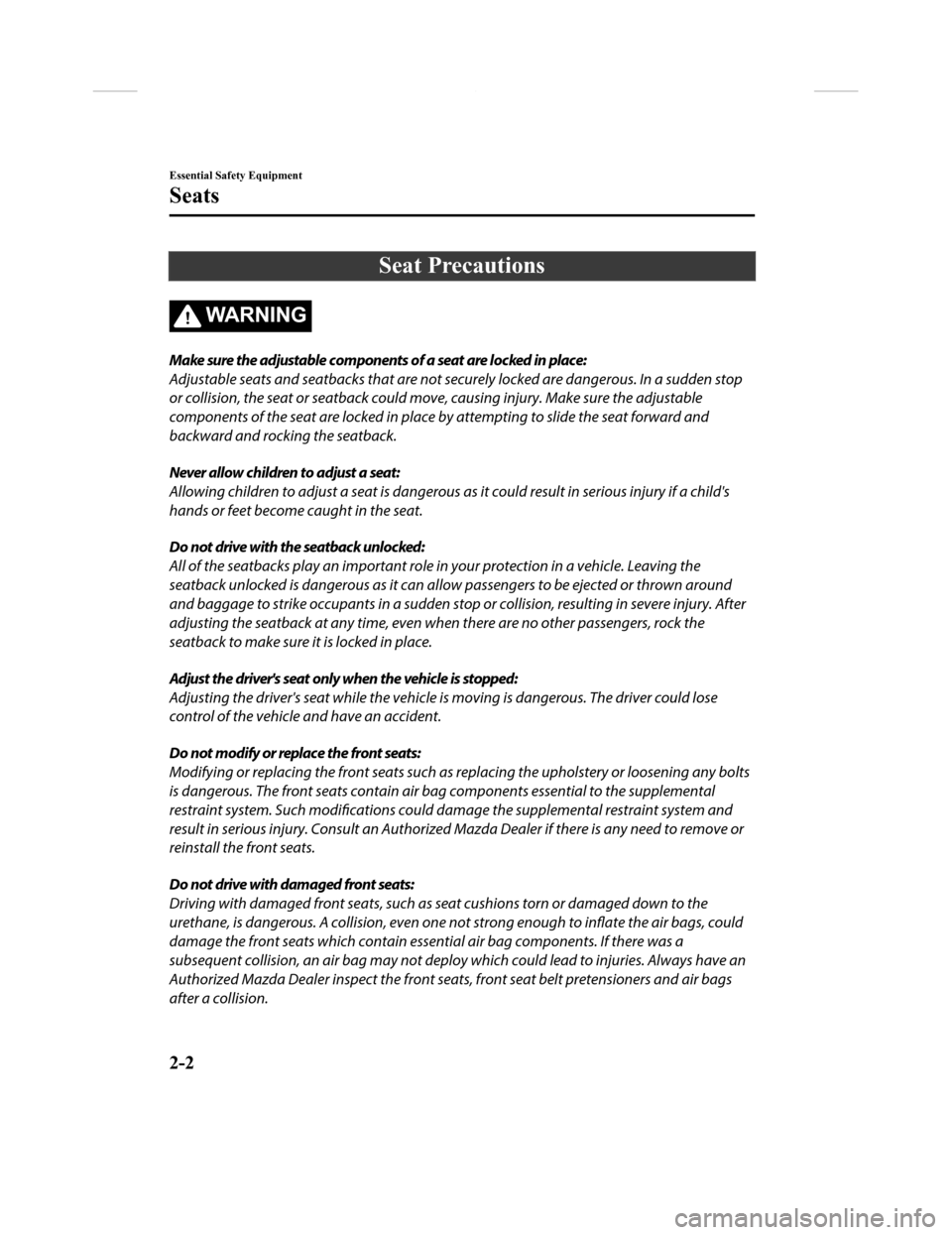
Seat Precautions
WA R N I N G
Make sure the adjustable components of a seat are locked in place:
Adjustable seats and seatbacks that are not securely locked are dangerous. In a sudden stop
or collision, the seat or seatback could move, causing injury. Make sure the adjustable
components of the seat are locked in place by attempting to slide the seat forward and
backward and rocking the seatback.
Never allow children to adjust a seat:
Allowing children to adjust a seat is dangerous as it could result in serious injury if a child's
hands or feet become caught in the seat.
Do not drive with the seatback unlocked:
All of the seatbacks play an important role in your protection in a vehicle. Leaving the
seatback unlocked is dangerous as it can a llow passengers to be ejected or thrown around
and baggage to strike occupants in a sudden stop or collision, resulting in severe injury. After
adjusting the seatback at any time, even when there are no other passengers, rock the
seatback to make sure it is locked in place.
Adjust the driver's seat only when the vehicle is stopped:
Adjusting the driver's seat while the vehicle is moving is dangerous. The driver could lose
control of the vehicle and have an accident.
Do not modify or replace the front seats:
Modifying or replacing the front seats such as replacing the upholstery or loosening any bolts
is dangerous. The front seats contain air bag components essential to the supplemental
restraint system. Such modifications could damage the supplemental restraint system and
result in serious injury. Consult an Authorized Mazda Dealer if there is any need to remove or
reinstall the front seats.
Do not drive with damaged front seats:
Driving with damaged front seats, such as se at cushions torn or damaged down to the
urethane, is dangerous. A collision, even one not strong enough to
inflate the air bags, could
damage the front seats which contain essential air bag components. If there was a
subsequent collision, an air bag may not deploy which could lead to injuries. Always have an
Authorized Mazda Dealer inspect the front seats, front seat belt pretensioners and air bags
after a collision.
Essential Safety Equipment
Seats
2-2
CX-9_8GC3-EA-17G_Edition1 2017-5-29 10:13:38
Page 15 of 640

Do not drive with either front seats reclined:
Sitting in a reclined position while the vehicle is moving is dangerous because you do not get
the full protection from seat belts. During sudden braking or a collision, you can slide under
the lap belt and suffer serious internal injuri es. For maximum protection, sit well back and
upright.
Do not recline a second-row seatback when the third-row seat is occupied:
Reclining the second-row seatback when the thir d-row seat is occupied is dangerous. Because
the clearance in the third-row seat is limited, occupants in the third-row seat could be hurt
seriously on a reclined second-row seatback.
Do not place an object such as a cushion between the seatback and your back:
Putting an object such as a cushion between the seatback and your back is dangerous
because you will be unable to maintain a safe driving posture and the seat belt cannot
function at its full capacity in a collision, wh ich could result in a serious accident, injury or
death.
Do not place objects under the seat:
The object could get stuck and cause the seat to not be fixed securely, and result in an
accident.
Do not stack cargo higher than the seatbacks:
Stacking luggage or other cargo higher than the seatbacks is dangerous. During sudden
braking or a collision, objects can fly around and become projectiles that may hit and injure
passengers.
Make sure luggage and cargo is secured before driving:
Not securing cargo while driving is dangerous as it could move or be crushed during sudden
braking or a collision and cause injury.
Never allow a passenger to sit or stand on the folded seatback while the vehicle is moving:
Driving with a passenger on the folded seatback is dangerous. Allowing a child to sit up on
the folded seatback while the vehicle is moving is particularly dangerous. In a sudden stop or
even a minor collision, a child not in a proper seat or child-restraint system and seat belt could
be thrown forward, back or even out of the vehi cle resulting in serious injuries or death. The
child in the baggage area could be thrown into other occupants and cause serious injury.
Essential Safety Equipment
Seats
2-3
CX-9_8GC3-EA-17G_Edition1 2017-5-29 10:13:38
Page 17 of 640
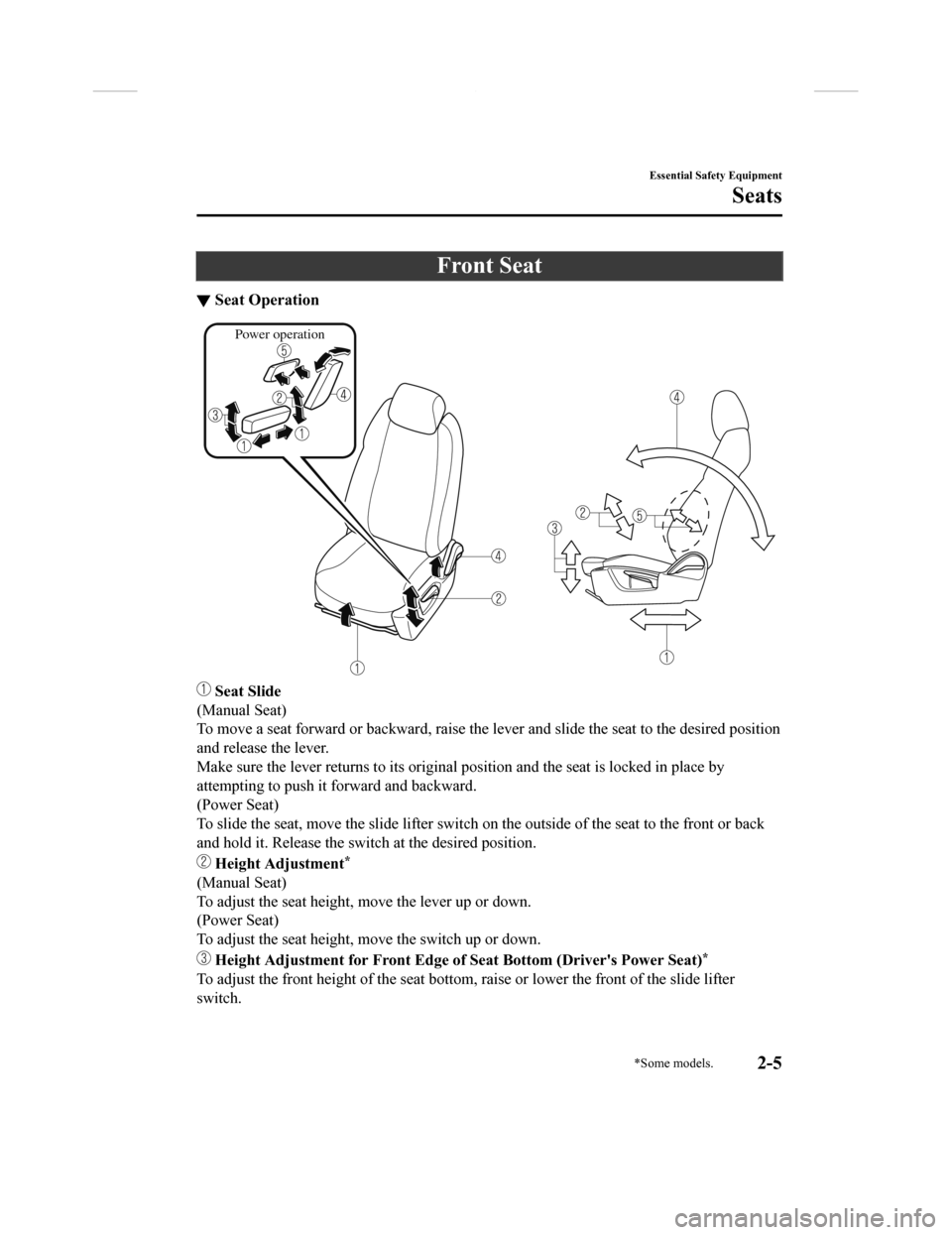
Front Seat
▼Seat Operation
Power operation
Seat Slide
(Manual Seat)
To move a seat forward or backward, raise the lever and slide t he seat to the desired position
and release the lever.
Make sure the lever returns to i ts original position and the seat is locked in place by
attempting to push it forward and backward.
(Power Seat)
To slide the seat, move the slide lifter switch on the outside of the seat to the front or back
and hold it. Release the sw itch at the desired position.
Height Adjustment*
(Manual Seat)
To adjust the seat height, move the lever up or down.
(Power Seat)
To adjust the seat height, move the switch up or down.
Height Adjustment for Front Edg e of Seat Bottom (Driver's Power Seat)*
To adjust the front height of the seat bottom, raise or lower t he front of the slide lifter
switch.
Essential Safety Equipment
Seats
*Some models.2-5
CX-9_8GC3-EA-17G_Edition1 2017-5-29 10:13:38
Page 20 of 640
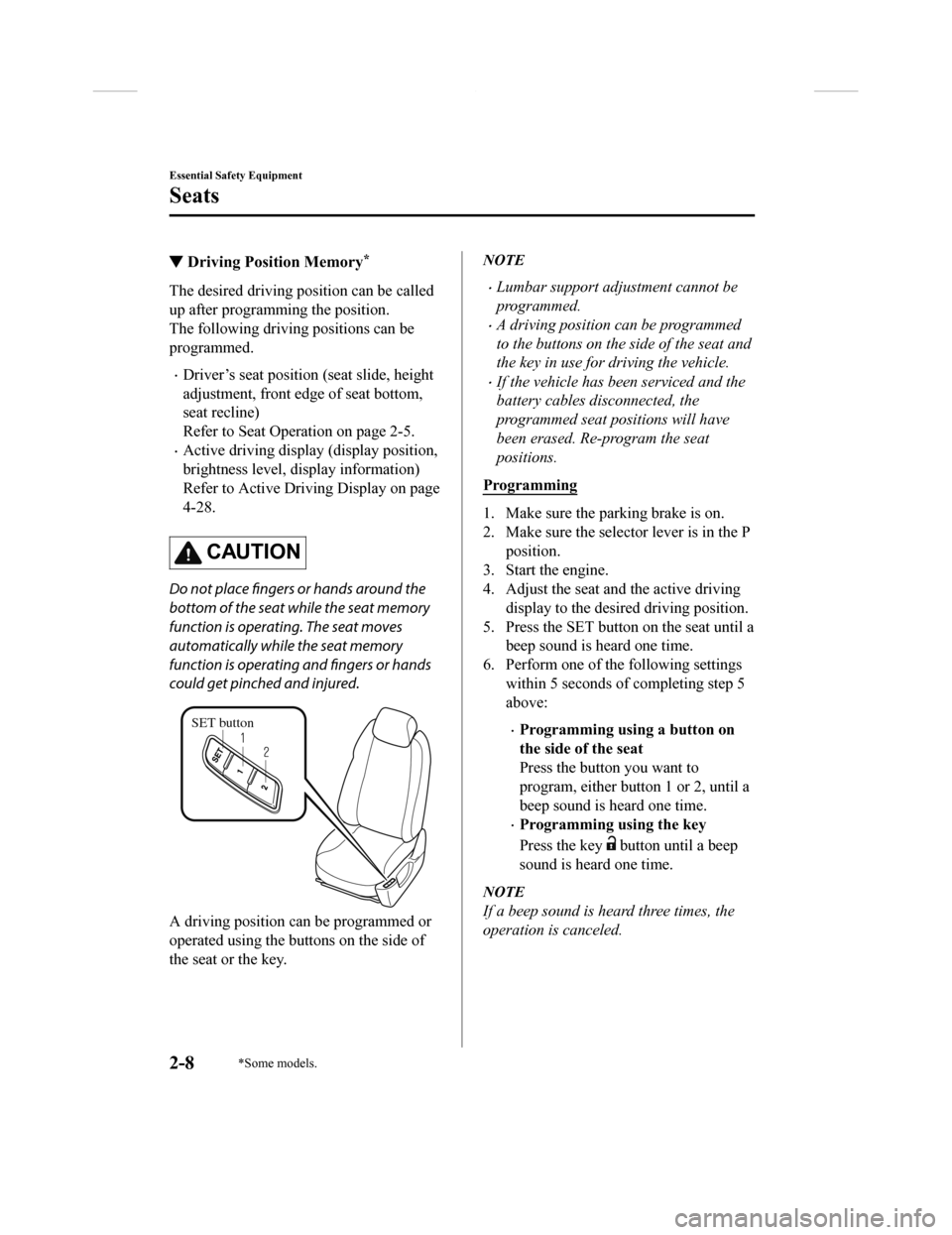
▼Driving Position Memory*
The desired driving position can be called
up after programming the position.
The following driving positions can be
programmed.
•Driver’s seat position
(seat slide, height
adjustment, front edge of seat bottom,
seat recline)
Refer to Seat Operation on page 2-5.
•Active driving display (display position,
brightness level, display information)
Refer to Active Driving Display on page
4-28.
CAUTION
Do not place fingers or hands around the
bottom of the seat while the seat memory
function is operating. The seat moves
automatically while the seat memory
function is operating and fingers or hands
could get pinched and injured.
SET button
A driving position can be programmed or
operated using the buttons on the side of
the seat or the key.
NOTE
•Lumbar support adjustment cannot be
programmed.
•A driving position can be programmed
to the buttons on the side of the seat and
the key in use for driving the vehicle.
•If the vehicle has been serviced and the
battery cables disconnected, the
programmed seat positions will have
been erased. Re-program the seat
positions.
Programming
1. Make sure the parking brake is on.
2. Make sure the selector lever is in the P position.
3. Start the engine.
4. Adjust the seat and the active driving display to the desired driving position.
5. Press the SET button on the seat until a beep sound is heard one time.
6. Perform one of the following settings within 5 seconds of completing step 5
above:
•Programming using a button on
the side of the seat
Press the button you want to
program, either button 1 or 2, until a
beep sound is heard one time.
•Programming using the key
Press the key
button until a beep
sound is heard one time.
NOTE
If a beep sound is heard three times, the
operation is canceled.
Essential Safety Equipment
Seats
2-8*Some models.
CX-9_8GC3-EA-17G_Edition1 2017-5-29 10:13:38
Page 30 of 640
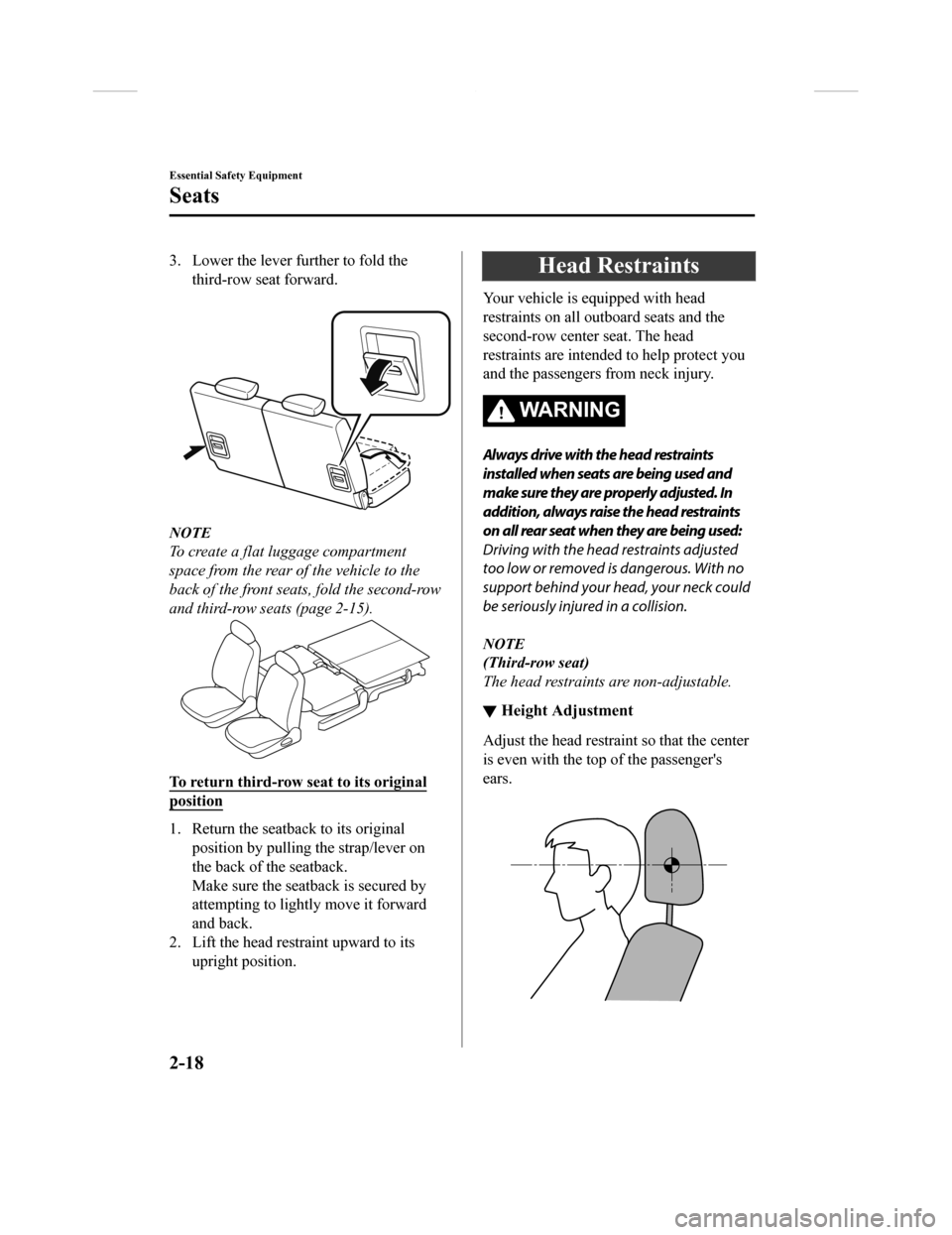
3. Lower the lever further to fold the
third-row seat forward.
NOTE
To create a flat luggage compartment
space from the rear of the vehicle to the
back of the front seats, fold the second-row
and third-row seats (page 2-15).
To return third-row seat to its original
position
1. Return the seatback to its original position by pulling the strap/lever on
the back of the seatback.
Make sure the seatback is secured by
attempting to lightly move it forward
and back.
2. Lift the head restraint upward to its
upright position.
Head Restraints
Your vehicle is equipped with head
restraints on all outboard seats and the
second-row center seat. The head
restraints are intended to help protect you
and the passengers from neck injury.
WA R N I N G
Always drive with the head restraints
installed when seats are being used and
make sure they are properly adjusted. In
addition, always raise the head restraints
on all rear seat when they are being used:
Driving with the head restraints adjusted
too low or removed is dangerous. With no
support behind your head, your neck could
be seriously injured in a collision.
NOTE
(Third-row seat)
The head restraints are non-adjustable.
▼Height Adjustment
Adjust the head restraint so that the center
is even with the top of the passenger's
ears.
Essential Safety Equipment
Seats
2-18
CX-9_8GC3-EA-17G_Edition1
2017-5-29 10:13:38
Page 31 of 640

To raise a head restraint, pull it up to the
desired position.
To lower the head restraint, press the
stop-catch release, then push the head
restraint down.
Front outboard seat
Second-row outboard seat
Second-row center seat
▼Removal/Installation
To remove the head restraint, pull it up
while pressing the stop-catch.
To install the head restraint, insert the legs
into the holes while pressing the
stop-catch.
WA R N I N G
Always drive with the head restraints
installed when seats are being used and
make sure they are properly installed:
Driving with the head restraints not
installed is dangerous. With no support
behind your head, your neck could be
seriously injured in a collision.
After installing a head restraint, try lifting it
to make sure that it does not pull out:
Driving with an unsecured head restraint is
dangerous as the effectiveness of the head
restraint will be compromised which could
cause it to unexpectedly detach from the
seat.
Essential Safety Equipment
Seats
2-19
CX-9_8GC3-EA-17G_Edition1
2017-5-29 10:13:38
Page 32 of 640
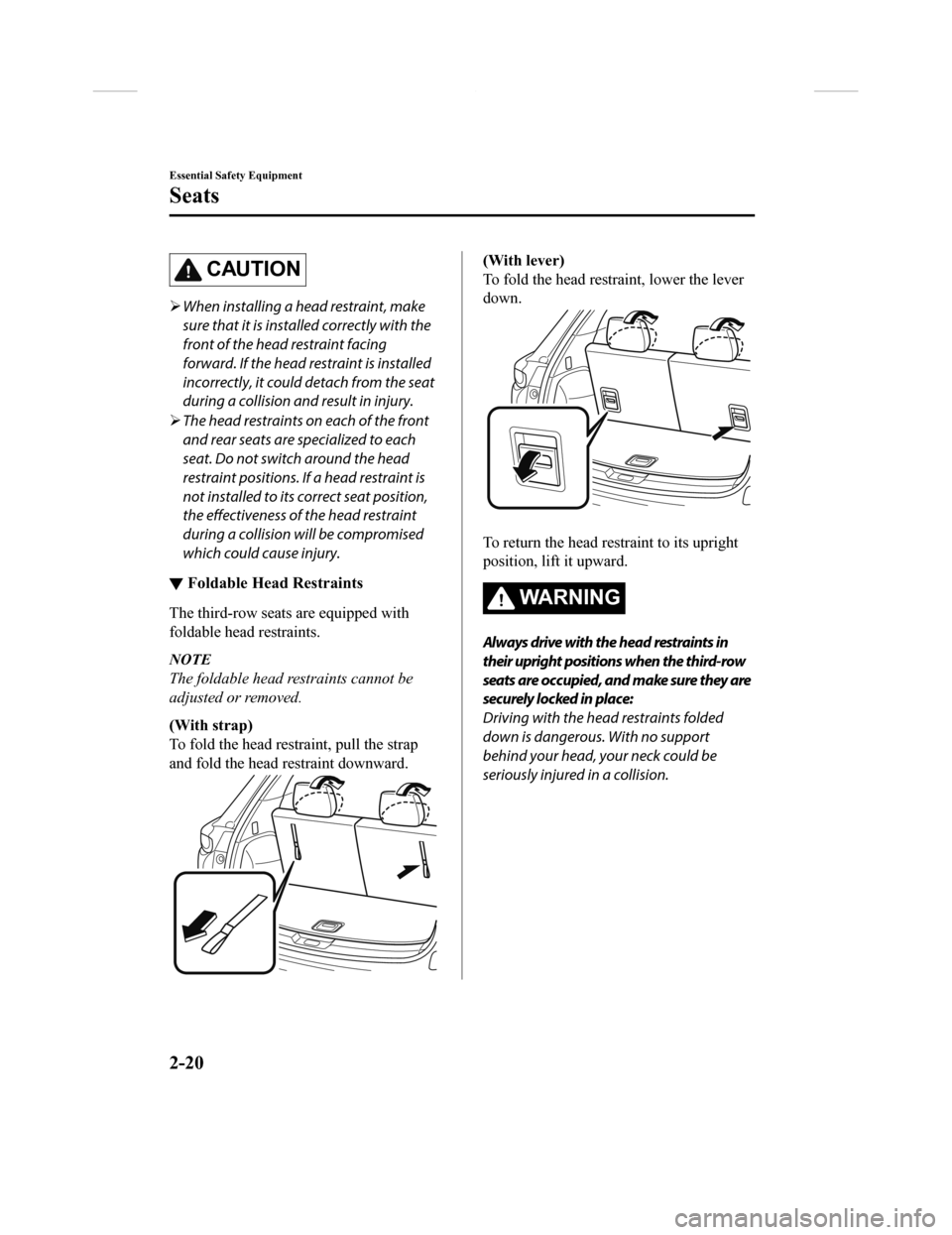
CAUTION
When installing a head restraint, make
sure that it is installed correctly with the
front of the head restraint facing
forward. If the head restraint is installed
incorrectly, it could detach from the seat
during a collision and result in injury.
The head restraints on each of the front
and rear seats are specialized to each
seat. Do not switch around the head
restraint positions. If a head restraint is
not installed to its correct seat position,
the effectiveness of the head restraint
during a collision will be compromised
which could cause injury.
▼ Foldable Head Restraints
The third-row seats are equipped with
foldable head restraints.
NOTE
The foldable head restraints cannot be
adjusted or removed.
(With strap)
To fold the head restra
int, pull the strap
and fold the head restraint downward.
(With lever)
To fold the head restraint, lower the lever
down.
To return the head res traint to its upright
position, lift it upward.
WA R N I N G
Always drive with the head restraints in
their upright positions when the third-row
seats are occupied, and make sure they are
securely locked in place:
Driving with the head restraints folded
down is dangerous. With no support
behind your head, your neck could be
seriously injured in a collision.
Essential Safety Equipment
Seats
2-20
CX-9_8GC3-EA-17G_Edition1 2017-5-29 10:13:38
Page 33 of 640
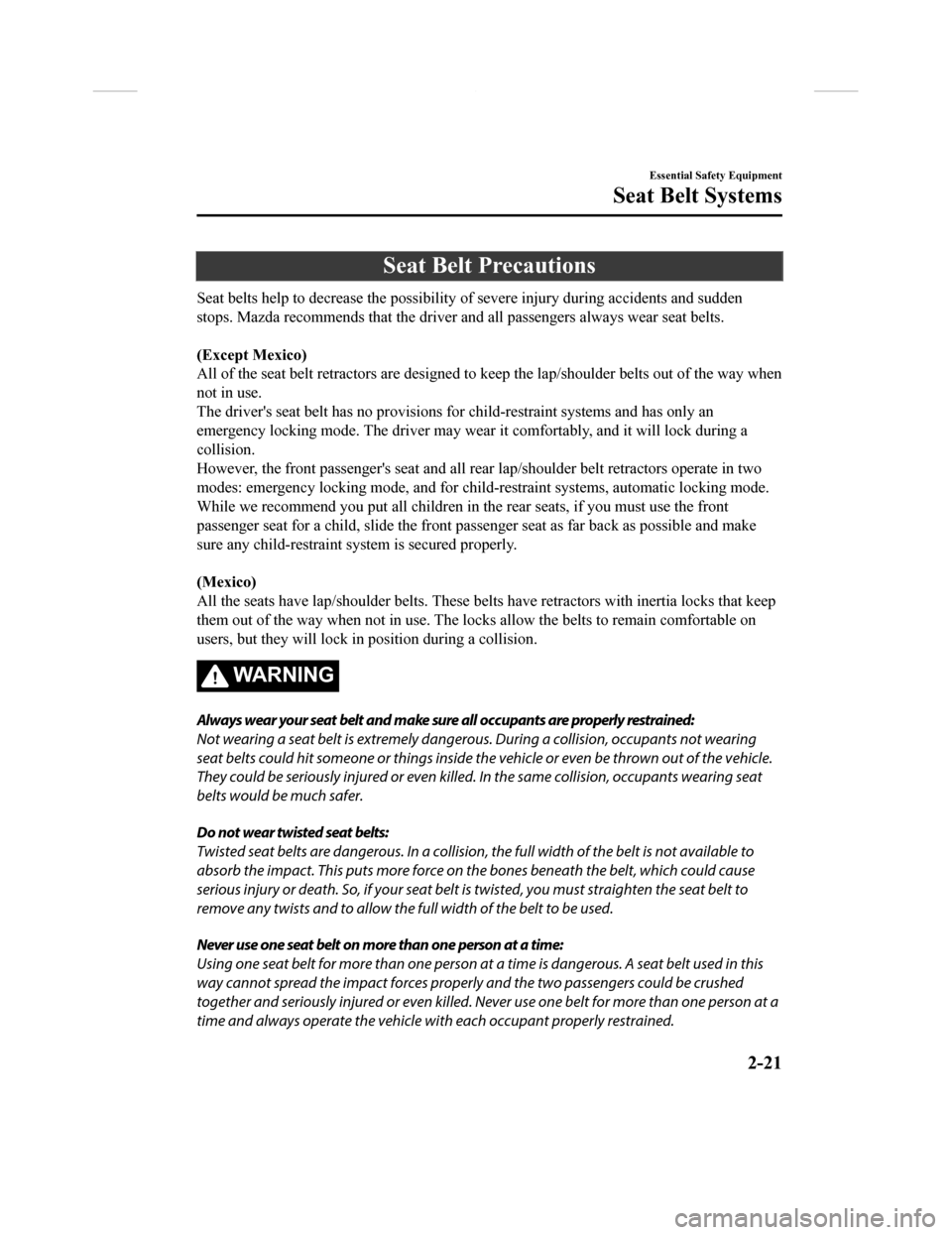
Seat Belt Precautions
Seat belts help to decrease the possibility of severe injury during accidents and sudden
stops. Mazda recommends that the driver and all passengers alwa ys wear seat belts.
(Except Mexico)
All of the seat belt retractors are designed to keep the lap/sh oulder belts out of the way when
not in use.
The driver's seat belt has no pr ovisions for child-restraint systems and has only an
emergency locking mode. The driver may wear it comfortably, and it will lock during a
collision.
However, the front passenger's s eat and all rear lap/shoulder belt retractors operate in two
modes: emergency locking mode, and for child-restraint systems, automatic locking mode.
While we recommend you put all children in the rear seats, if y ou must use the front
passenger seat for a child, slide the front passenger seat as far back as possible and make
sure any child-restraint sy stem is secured properly.
(Mexico)
All the seats have lap/shoulder belts. These belts have retract ors with inertia locks that keep
them out of the way when not in use. The locks allow the belts to remain comfortable on
users, but they will lock in position during a collision.
WA R N I N G
Always wear your seat belt and make sure all occupants are properly restrained:
Not wearing a seat belt is extremely dangerou s. During a collision, occupants not wearing
seat belts could hit someone or things inside the vehicle or even be thrown out of the vehicle.
They could be seriously injured or even killed. In the same collision, occupants wearing seat
belts would be much safer.
Do not wear twisted seat belts:
Twisted seat belts are dangerous. In a collision, the full width of the belt is not available to
absorb the impact. This puts more force on the bones beneath the belt, which could cause
serious injury or death. So, if your seat belt is twisted, you must straighten the seat belt to
remove any twists and to allow the fu ll width of the belt to be used.
Never use one seat belt on more than one person at a time:
Using one seat belt for more than one person at a time is dangerous. A seat belt used in this
way cannot spread the impact forces properly and the two passengers could be crushed
together and seriously injured or even killed. Ne ver use one belt for more than one person at a
time and always operate the vehicle wi th each occupant properly restrained.
Essential Safety Equipment
Seat Belt Systems
2-21
CX-9_8GC3-EA-17G_Edition1 2017-5-29 10:13:38
Page 38 of 640
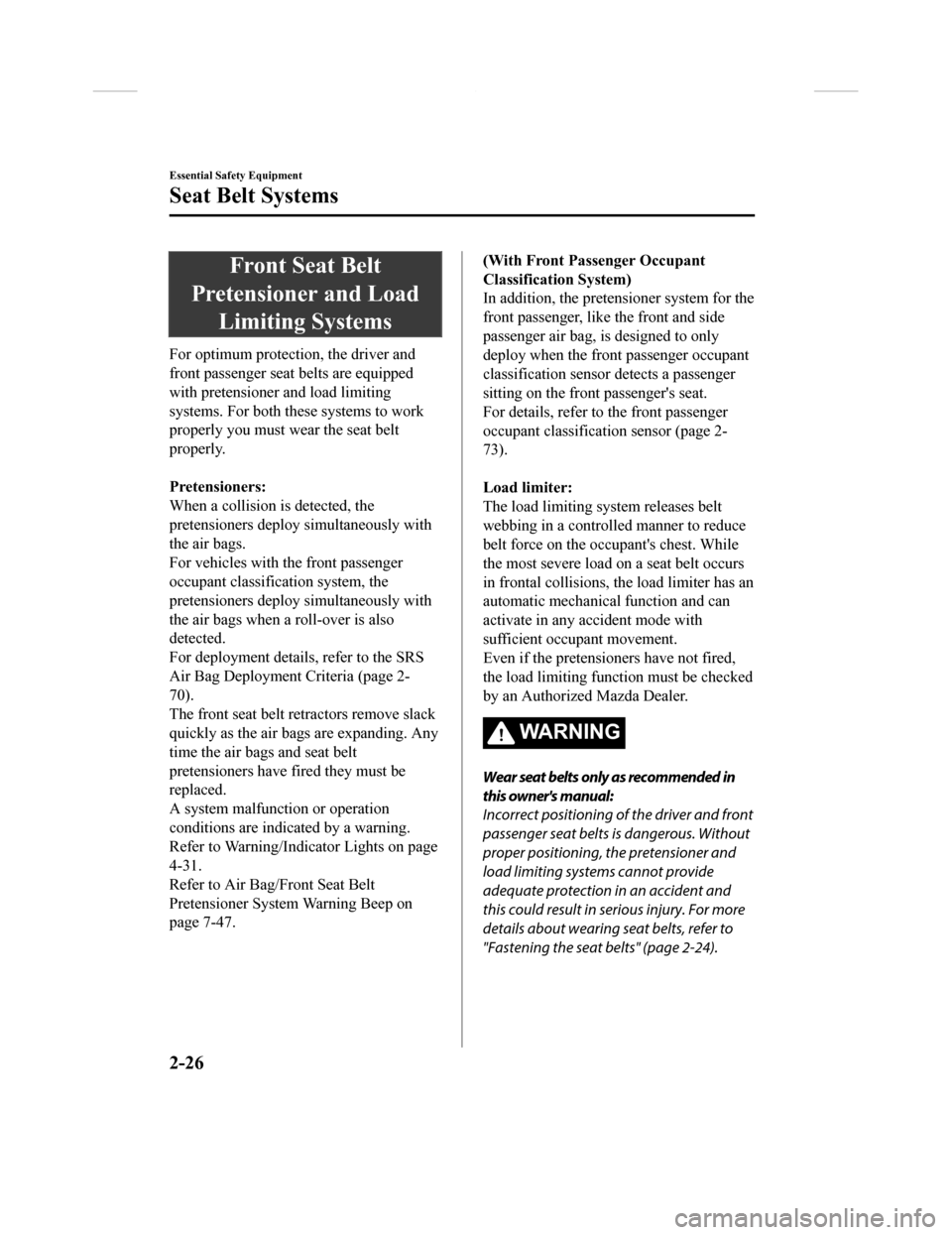
Front Seat Belt
Pretensioner and Load Limiting Systems
For optimum protection, the driver and
front passenger seat belts are equipped
with pretensioner and load limiting
systems. For both these systems to work
properly you must wear the seat belt
properly.
Pretensioners:
When a collision is detected, the
pretensioners deploy simultaneously with
the air bags.
For vehicles with t he front passenger
occupant classification system, the
pretensioners deploy simultaneously with
the air bags when a roll-over is also
detected.
For deployment details, refer to the SRS
Air Bag Deployment Criteria (page 2-
70).
The front seat belt retractors remove slack
quickly as the air bags are expanding. Any
time the air bags and seat belt
pretensioners have fired they must be
replaced.
A system malfunction or operation
conditions are indicated by a warning.
Refer to Warning/Indicator Lights on page
4-31.
Refer to Air Bag/Front Seat Belt
Pretensioner System Warning Beep on
page 7-47.
(With Front Passenger Occupant
Classification System)
In addition, the pretensioner system for the
front passenger, like the front and side
passenger air bag, is designed to only
deploy when the front passenger occupant
classification sensor detects a passenger
sitting on the front passenger's seat.
For details, refer to the front passenger
occupant classification sensor (page 2-
73).
Load limiter:
The load limiting system releases belt
webbing in a controlled manner to reduce
belt force on the occupant's chest. While
the most severe load on a seat belt occurs
in frontal collisions, th e load limiter has an
automatic mechanical function and can
activate in any accident mode with
sufficient occupant movement.
Even if the pretensioners have not fired,
the load limiting function must be checked
by an Authorized Mazda Dealer.
WA R N I N G
Wear seat belts only as recommended in
this owner's manual:
Incorrect positioning of the driver and front
passenger seat belts is dangerous. Without
proper positioning, the pretensioner and
load limiting systems cannot provide
adequate protection in an accident and
this could result in serious injury. For more
details about wearing seat belts, refer to
"Fastening the seat belts" (page 2-24).
Essential Safety Equipment
Seat Belt Systems
2-26
CX-9_8GC3-EA-17G_Edition1 2017-5-29 10:13:38
Page 41 of 640

Do not leave a seat belt extender
connected to the buckle:
Leaving a seat belt extender connected to
the buckle without using the seat belt is
dangerous. When the seat belt extender is
connected to the driver's seat belt buckle
(or front passenger's seat belt buckle), the
SRS driver's (or front passenger's) air bag
system will determine that the driver (or
front passenger) is wearing the seat belt
even if the driver (or front passenger) is not
wearing it. This condition could cause the
driver's (or front passenger's) air bag to not
activate correctly and result in death or
serious injury in the event of collision.
Always wear the seat belt with the seat belt
extender.
Do not use the seat belt extender when
installing a child-restraint system on the
front or rear passenger seat:
Using a seat belt extender to fasten a
child-restraint system on any seat is
dangerous. Always follow the
child-restraint system manufacturer's
installation instructions and never use a
seat belt extender.
NOTE
When not in use, remove the seat belt
extender and store it in the vehicle. If the
seat belt extender is left connected, the
seat belt extender might get damaged as it
will not retract with the rest of the seat belt
and can easily fall out of the door when
not in use and be damaged. In addition,
the seat belt warning light will not
illuminate and function properly.
Essential Safety Equipment
Seat Belt Systems
2-29
CX-9_8GC3-EA-17G_Edition12017-5-29 10:13:38